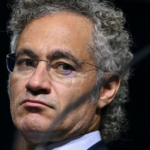Tech company earnings appear to be driving the stock markets upward today after Palantir delivered a massive quarter after the markets closed in the U.S. last night. S&P 500 futures were up 0.27% this morning, premarket. Europe and Asia were broadly up this morning, too.
But lurking in the background, as always, are the big macro questions about whether President Trump’s tariff deals have hobbled the U.S. economy in the long run.
That prospect—the idea that tech companies can grow by replacing employees with AI—appears to have energized investors in tech stocks broadly. Palantir’s call was “eye-popping,” Wedbush’s Daniel Ives said this morning.
Look at the closing prices of this selection of tech darlings:
Goldman Sachs reported that its Risk Appetite Indicator was above zero for July, indicating a general risk-on attitude for equities.
Investors are also assuming that the U.S. Federal Reserve’s next interest rate cut will come in September and not December, as previously assumed. The CME’s Fed funds futures market is showing an 88% likelihood of a cut in September and a 60% likelihood of a cut in October. Cheaper money = higher stock prices, of course.
In the long term, there are obvious problems ahead. Goldman Sachs said today that new job creation—yes, the jobs number that was so controversial on Friday—is now so meager that the U.S. economy is in danger of stalling.
“Friday’s jobs numbers reinforced our view that U.S. growth is near stall speed—a pace below which the labor market weakens in a self-reinforcing fashion. So far, the unemployment rate has only risen modestly, from an average of 4.1% in Q1 to 4.248% in July. But our estimate of underlying monthly job growth—which is based on moving averages of real-time gains in the establishment survey and the household survey—has plummeted from 206K in Q1 to just 28K in July, well below our 90K estimate of the current break-even pace,” chief economist Jan Hatzius told clients.
DOGE cuts knocked 0.3 percentage points from GDP growth in Q2, according to Pantheon Macroeconomics’ Samuel Tombs and Oliver Allen. Their estimate for GDP growth was dragged down by “an enormous 11.2% drop in federal nondefense spending, dragging down headline GDP growth by 0.3 percentage points,” they told clients.
Trump has specifically targeted the BRICS countries (Brazil, Russia, India, China, South Africa, and allied regimes) for high tariffs. The China tariff deal—not yet done—is the big kahuna in all of this. If China also gets a high percentage rate, investors will down-rate stocks, Chris Turner’s team at ING told clients.
“An early extension of the currently benign trading conditions would very much be welcomed by the market. If not, and the U.S. does ratchet up pressure on China again, then it would look like President Trump was opening up a new campaign on the BRICS nations after all,” they said.
Here’s a snapshot of the action prior to the opening bell in New York:









